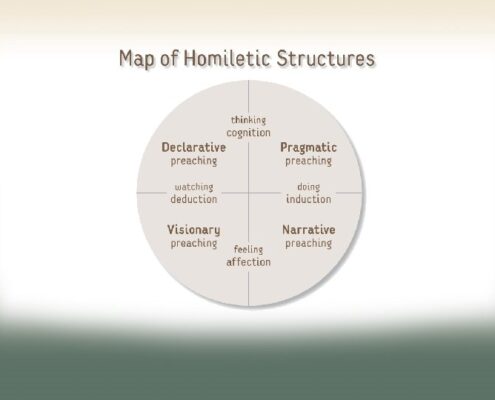How To Create An Integrative Sermon
How To Create An Integrative Sermon
There is one more “map” to consider as we consider new ways of thinking about organizing your sermon. The Integrative Sermon attempts to bring together all the elements we looked at in previous posts. So the title to this post is: how to create an integrative sermon for your audience.
Description of the Integrative Sermon
Here is how Kenton Anderson describes the integrative sermon in his book, Choosing To Preach:
 Integrative preaching seeks to offer sermons that bring together all of the primary homiletic structures in order to speak to all four learning styles at once. Integrative preaching, then, is both deductive and inductive. One might say that it is “abductive.” Integrative preaching is both cognitive and affective. We could say that it is “behavioral” preaching. This kind of preaching is not content to focus on one group of people but hopes to offer something for every person and for every part of a person. It is a holistic form of preaching that speaks to the whole person at once.” (pp. 235-236)
Integrative preaching seeks to offer sermons that bring together all of the primary homiletic structures in order to speak to all four learning styles at once. Integrative preaching, then, is both deductive and inductive. One might say that it is “abductive.” Integrative preaching is both cognitive and affective. We could say that it is “behavioral” preaching. This kind of preaching is not content to focus on one group of people but hopes to offer something for every person and for every part of a person. It is a holistic form of preaching that speaks to the whole person at once.” (pp. 235-236)
When we were talking about the visionary sermon, I likened it to an artist painting a picture. The Integrative Sermon is more like creating music. Music is a way of expressing ourselves.
The Music of the Integrative Sermon
When you write a song, you engage in various forms of thinking. You think deductively, in the sense that you follow rules of notes and harmony (at least most do). However, in a creative burst, you may go beyond those boundaries, combining new ways of approaching a subject. This, in a way, is how to creative an integrative sermon for your church. You would combine old ideas into new patterns so that, hopefully, someone has an “aha” moment.
An Example of Sermon Music
I was recently reading the memoir of one of my favorite authors, Phillip Yancey. In it, he shares a powerful spiritual  experience that awakened a fresh view of the parable of the Good Samaritan for me. Yancey, pretty much a skeptic and the agnostic on his Christian College campus, was assigned to pray with 3 other men. He never prayed in this group, until one night, to the consternation of his prayer-mates, he began to talk to God about how he didn’t really care about all the people going to hell around him. I am going to quote him at some length, because this is a wonderful piece of music, creating a song of grace:
experience that awakened a fresh view of the parable of the Good Samaritan for me. Yancey, pretty much a skeptic and the agnostic on his Christian College campus, was assigned to pray with 3 other men. He never prayed in this group, until one night, to the consternation of his prayer-mates, he began to talk to God about how he didn’t really care about all the people going to hell around him. I am going to quote him at some length, because this is a wonderful piece of music, creating a song of grace:
Yancey’s Story
“God, here we are, supposed to be concerned about those ten thousand students at the university who are going to Hell. Well, you know that I don’t care if they all go to Hell, if there is one. I don’t care if I go to Hell.”…For some reason, I start talking about the parable of the Good Samaritan, which one of my classes has just been studying. “We’re supposed to feel the same concern for the university students as the Samaritan felt for the bloodied Jew lying in the ditch,” I pray. “I feel no such concern. I feel nothing.”
And then it happens. In the middle of my prayer, as I am admitting my lack of care for our designated targets of compassion, the parable comes to me in a new light…the Samaritan takes on the face of Jesus. The Jew, pitiable victim of a highway robbery, also takes on another face–one I recognize with a start as my own.
In slow motion, I watch Jesus reach down with a moistened rag to clean my wounds and stanch the flow of blood. As he bends toward me, I see myself, the wounded victim of a crime, open my eyes and spit on him, full in the face. Just like that. The image unnerves me…I am rendered speechless. Abruptly, I stop praying, rise, and leave the room.
All of a sudden, I saw this parable in a new sense. Prior to this description, I usually interpreted this passage as a call to care about my neighbor. Now I saw it as God caring about me.
Anderson on This Subject
Perhaps the best person to describe the integrative sermon is Kenton Anderson himself. Here he is giving a short description of how to create an integrative sermon for your congregation.



